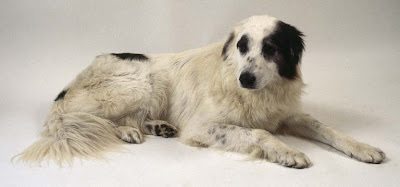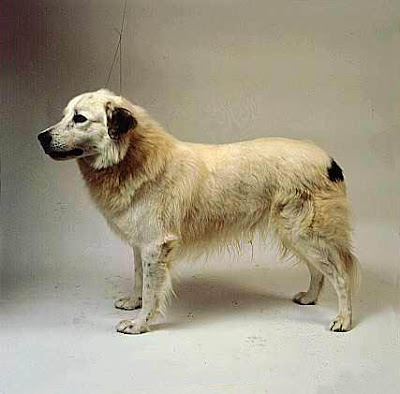Aidi Dog (Atlas Mountain Dog) Solid, very hardy dog, noted for its power and mobility; it is well-muscled, sinewy, strongly built but not cumbersome and possessing a thick bushy coat which protects it equally from the sun and from the cold of its native mountains. This fleece provides a protective armour in the fights which the Atlas dog has to undertake against jackals and other predators. It has a lively, direct and decided gaze as befits an alert dog always ready to fulfil its guarding role. In some regions of Marocco it is customary to crop the ears and even dock the tail of working dogs.
Aidi (Atlas Mountain Dog) History
The Aidi Dog has existed since time immemorial in the mountains and on the plateaux of North Africa. At present it can be found in large numbers in the Atlas Mountains of Morocco, the country which holds the breed standard. The Atlas Mountain
Dog is closely linked to the semi-nomadic pastoral populations of the mountaneous regions and has the clear role of defending its masters’ tent and belongings as well as protecting the flocks from wild beasts which might attack them. There are no sheepdogs in the Atlas region. The Moroccan dog which lives in our mountains has never guarded flocks in the European sense of the world (herding flocks).Aidi (Atlas Mountain Dog) TEMPERAMENT : Very faithful, affectionate and docile with its owner and family members, the Atlas Dog displays inherent guarding and remarkable protective behaviour. Always alert, it instinctively measures the gravity and proximity of any danger and fearlessly provides an appropriate and efficient response.
HEAD : A strong, broad head, well-proportioned in relation to the whole body, its general shape is conical; the head is free from wrinkles and has no prominent muscles; the cheek-bones are not chiselled and link the skull to the muzzle on the same plane without a break. Skull : The skull is flat and broad; a slight frontal groove appears and the occipital protuberance, although present, is scarcely perceptible. Stop : Only slightly pronounced. Nose : Black or brown in harmony with coat colour, it is reasonably broad with open nostrils. Muzzle : Conical like the rest of the head; it is appreciably less long than the skull; the stop is sloping and not very defined. Lips : Thin, tight, black or brown according to coat colour.
Jaws : Strong, armed with well-set, powerful, white, regular teeth. Teeth : The bite is pincer (edge to edge incisors). Scissor-bite or reverse scissor-bite without loss of contact between the incisors is tolerated. Eyes : Moderate size, dark shade, varying with the coat colour, from dark amber to golden brown. Slightly oblique and well-pigmented, the eye-lids appear painted on light-coloured coats. The gaze is very alert, attentive and scrutinising. Ears : Medium length with slightly rounded tips, the ears are set obliquely so as to leave the skull clear; they are carried half-dropped, raised forward when alert and sometimes carried back when in repose.
BODY :
Topline : The topline must show a slightly dipping profile, without being sway-backed. Back : Broad, well-muscled back of reasonable length, followed by powerful, very muscled and slightly arching loin. Croup : Harmoniously sloping. Chest : Adequate width, long and well let-down, reaching at least as far as the elbows, slightly rounded rib-cage. Underline : Rising behind the false ribs without being whippety.
TAIL : Long, reaching at least to the hocks, it is set on the extension of the line of croup, carried low, scimitar fashion in repose. The tail is very bushy and the richness of the plume denotes pure breeding. On the move, the dog carries its tail much more gaily. The tail should never be permanently carried curled over the back.
HAIR : Thick, rather harsh, half-long, about 6 cm long apart from on the face and ears where it is short and finer. On the neck and under the throat, it forms a mane, especially in males. The breeches and tail are covered with well-furnished and very long hairs.
COLOUR : The coat colour is very variable.
· Fawn : From washed sand to deep red. These coats can be brindled, with black overlay or carrying a mantle of any hue. This mantle can be widely spread.
· Brown : From beige to burned bread shade. The lightest tones can have a deeper brown mantle.
· Black.
All these coats can be spotted with white, the spots can go from a few discreet marks to a complete covering (white coat). The lips and nose must always be strongly pigmented black or brown (depending on coat colour). Harlequin, blue, isabella are not acceptable.


















0 comments:
Post a Comment